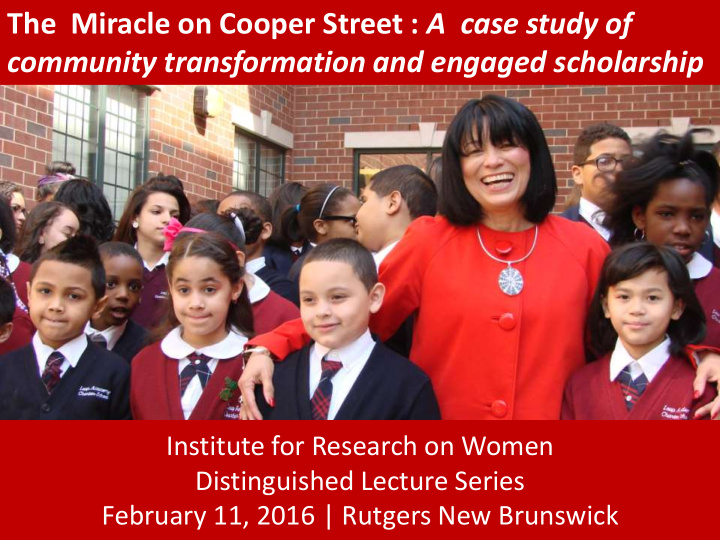



The Miracle on Cooper Street : A case study of community transformation and engaged scholarship Institute for Research on Women Distinguished Lecture Series February 11, 2016 | Rutgers New Brunswick
Presenter Dr. Gloria Bonilla-Santiago Board of Governors Distinguished Service Professor in Public Policy and Administration, Rutgers-Camden; Director of the Rutgers-Camden Community Leadership Center (CLC); Founder and Chair of LEAP Academy Charter School
Case study of community transformation through a combination of elements: • Quality Education • Visionary Leadership • Community Engagement • University Partnership
VIDEO PRESENTATION
LEAP in Context • Public charter schools drive neighborhood revitalization, merging the urban education and community development fields • Public charter schools foster stronger relationships with communities by de-centralizing operations
• Schools have the ability to foster relationships between various power structures of communities and elites, creating a path to economic security. • Schools that partner with anchor institutions have a major impact in neighborhood development efforts.
• Schools connect youth to adult conventional norms and adapting them to mainstream societal and economic structures.
The Collective Mission Statement The mission of the LEAP Academy is to enhance opportunities for the children and families of Camden through the collaborative design, implementation, and integration of education, health and human services, professional development, and community development .
LEAP Historical Milestones
Stakeholder Analysis/Engagement • Faculty and Staff • Legislators (State and Local) • University President • Governor • Board of Governors • State and Local Officials • Students • Camden Board of Educuation • Delaware River Port Authority • Foudantions/Funders • Parents • Business • Neighborhood • Community based and leaders service organizations
LEAP Values 1. Student Achievement – Comes first 2. We do what ever It takes to get the job Done. 3. We take the High Road 4. We are a Family 5. Positive and Caring Culture 6. We are all Accountable 7. Transparency with each other 8. Improvement is ongoing 9. Diversity is our Strength 10.We are one Team
Five Core Elements of the LEAP Model
1.Accountability for People, Time, Money and Programs
2. Pipeline of College Access for all students PreK- 16
3. Teacher Development and Support
4. Parental Engagement
5. Early Learning means Later Earning
A Focus on Pipeline Development The Rutgers/LEAP Pipeline to College 19
BIRTH – 16 EDUCATIONAL INVESTMENTS AND INNOVATIONS
POINT S OF PRIDE • School based centers to channel university support for the school. – Health and Wellness , offering primary health and social work services to families and children – Early Learning Research Academy offering a infants and pre-school curriculum
– Fabrication Lab, offering innovative products and project base learning opportunities; – Parents Academy providing programs to strengthen the skills of families;
– Center for College Access working with students, teachers and families in ensuring college preparedness – Legal Enrichment Center offering free legal services and educational programming to families; applied research, academic training, and experiential learning for law school and LEAP students
Enrollment Profile of the Birth-12th Pipeline • 1,705 students Birth through 12th • LEAP Academy – Lower Elementary Campus (K-3) – Upper Elementary (4-6) – Intermediate High School (7-9) – High School (10-12) • Early Learning Research Academy – Infants (6 months - 1 year) – Toddlers (age 1-3 ) – Preschoolers (ages 3-4)
Children Impacted: Educational Pipeline Five-Year Enrollment Trends ELRA, LEAP, Combined 4000 1,705 1,519 3000 1,320 2000 986 1,380 841 1,313 1,194 1000 860 751 325 206 126 126 90 0 2011 2012 2013 2014 2015 Five-Years ELRA LEAP Combined
Factors of LEAP Model
Family Engagement
Core Elements of LEAP’s Family Engagement Framework
LEAP Principles for Family Engagement
IMPACT
• 100% in 2010 • 100% in 2005 • 100% in 2011 • 100% in 2006 • 100% in 2012 • 100% in 2007 • 100% in 2013 • 100% in 2008 • 100% in 2014 • 100% in 2009 • 100% in 2015
Transforming Cooper Street and the Educational Corridor
(PK-6): 639 Cooper Street
(7-12): 549 Cooper Street
528 Cooper Street
501 Cooper Street
130 North Broadway, Camden
SCHOOLS AS NEXUS FOR COMMUNITY DEVELOPMENT
Theory of Action
Logic Model of Outcomes Children Families & Community Youth Better outcomes for Better outcomes for Better outcomes children and youth families for the community Strong Early Childhood Programs Safe schools and neighborhoods Quality health services High Performing Schools Social service programs Business development Effective K-12 programs Crime prevention Adult learning opportunities and Job readiness training Higher high school graduation Local/community based rates leadership development Neighborhood based employment opportunities Successful transitions from high Better housing options and school to college/career support for residents Legal services Academic enrichment programs Community Building and Ownership Social, recreation and character building for children and youth Interagency Collaboration
Lessons Learned from our Applied Work
• We will never eradicate poverty without quality education for all Children
• Education counts because it helps eradicate poverty and hunger
• Education gives people the knowledge and skills they need to live better lives
• Education can boots productivity and open doors to job credits
• Poverty is one of the main reasons why children are left out of education
• A collaborative, comprehensive approach, with intentional alignment across institutions and contexts ( e.g. family, school, the broader community ), instead of piecemeal, uncoordinated efforts; • Participation by diverse partners instead of single-sector initiatives;
• A focus on geographically defined areas instead of being too broad in scope; • A governance structure that includes a lead organization to drive the effort instead of a leaderless coalition; • Active engagement by residents instead of purely top-down decisions;
• Cross fertilization between students and faculty to engage in research, service learning and community development; • An asset-based approach that builds on existing resources and strengths rather than considering communities as deficits to be remediated; and
• Flexible, non-categorical funding from diverse sources instead of restricted funds that constrain nimble actions
Recommend
More recommend